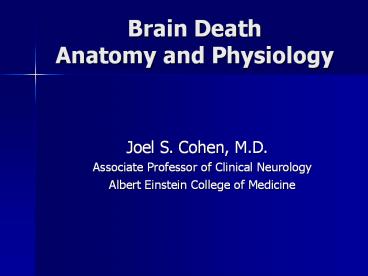Brain Death Anatomy and Physiology - PowerPoint PPT Presentation
Title:
Brain Death Anatomy and Physiology
Description:
Brain Death Anatomy and ... Confirmatory Testing Cerebral Angiography Confirmatory Testing Technetium-99 Isotope Brain Scan Confirmatory Testing MR- Angiography ... – PowerPoint PPT presentation
Number of Views:117
Avg rating:3.0/5.0
Title: Brain Death Anatomy and Physiology
1
Brain DeathAnatomy and Physiology
- Joel S. Cohen, M.D.
- Associate Professor of Clinical Neurology
- Albert Einstein College of Medicine
2
Historical Perspective
- Prior to the advent of mechanical respiration,
death was defined as the cessation of circulation
and breathing
3
Historical Perspective
- 1959 Coma depasse Mollaret and Goulon
- 1968 Irreversible Coma/Brain Death Harvard
Medical School Ad Hoc Committee - 1981 Uniform Determination of Death Act -
Presidents Commission for the Study of Ethical
Problems in Medicine - 1994 American Academy of Neurology Guidelines for
the determination of Brain Death - 2005 NYS Guidelines for Determining Brain Death
4
Brain Death Current Consensus
- Absent Cerebral Function
- Absent Brainstem Function
- Apnea
5
Normal Brain Anatomy
6
Normal Brain Anatomy
Cerebral Cortex
Reticular Activating System
Brain Stem
7
Cerebral Cortex
- Cognition
- Voluntary Movement
- Sensation
8
Brain Stem
9
Brain Stem
- Midbrain
- Cranial Nerve III
- pupillary function
- eye movement
10
Brain Stem
- Pons
- Cranial Nerves IV, V, VI
- conjugate eye movement
- corneal reflex
11
Brain Stem
- Medulla
- Cranial Nerves IX, X
- Pharyngeal (Gag) Reflex
- Tracheal (Cough) Reflex
- Respiration
12
Reticular Activating System
- Receives multiple sensory inputs
- Mediates wakefulness
13
Causes of Brain Death
Cerebral Anoxia
Normal
14
Causes of Brain Death
Normal
Cerebral Hemorrhage
15
Causes of Brain Death
Subarachnoid Hemorrhage
Normal
16
Causes of Brain Death
Normal
Trauma
17
Causes of Brain Death
Meningitis
Normal
18
Mechanism of Cerebral Death
ICPgtMAP is incompatible with life
Increased Intracranial Pressure
19
Conditions Distinct From Brain Death
- Persistent Vegetative State
- Locked-in Syndrome
- Minimally Responsive State
20
Persistent Vegetative State
- Normal Sleep-Wake Cycles
- No Response to Environmental Stimuli
- Diffuse Brain Injury with Preservation of Brain
Stem Function
21
Locked-in Syndrome
Ventral Pontine Infarct
- Complete Paralysis
- Preserved Consciousness
- Preserved Eye Movement
22
Minimally Responsive State
Static Encephalopathy
- Diffuse or Multi-Focal Brain Injury
- Preserved Brain Stem Function
- Variable Interaction with Environmental Stimuli
23
Brain Death Neurological Examination
- Clinical Prerequisites
- Known Irreversible Cause
- Exclusion of Potentially Reversible Conditions
- Drug Intoxication or Poisoning
- Electrolyte or Acid-Base Imbalance
- Endocrine Disturbances
- Core Body temperature gt 32 C
24
Brain Death Neurological Examination
- Coma
- Absent Brain Stem Reflexes
- Apnea
25
Coma
- No Response to Noxious Stimuli
- Nail Bed Pressure
- Sternal Rub
- Supra-Orbital Ridge Pressure
26
Absence of Brain Stem Reflexes
- Pupillary Reflex
- Eye Movements
- Facial Sensation and Motor Response
- Pharyngeal (Gag) Reflex
- Tracheal (Cough) Reflex
27
Pupillary Reflex
Pupils dilated with no constriction to bright
light
28
Eye Movements
Occulo-Cephalic Response Dolls Eyes Maneuver
29
Eye Movements
Oculo-Vestibular Response Cold Caloric Testing
30
Facial Sensation and Motor Response
- Corneal Reflex
- Jaw Reflex
- Grimace to Supraorbital or
- Temporo-Mandibular Pressure
31
Apnea Testing
- Prerequisites
- Core Body Temperature gt 32 C
- Systolic Blood Pressure 90 mm Hg
- Normal Electrolytes
- Normal PCO2
32
Apnea Testing
- 1. Pre-Oxygenation
- 100 Oxygen via Tracheal Cannula
- PO2 200 mm Hg
- 2. Monitor PCO2 and PO2 with pulse oximetry
- 3. Disconnect Ventilator
- 4. Observe for Respiratory Movement until PCO2
60 mm Hg - 5. Discontinue Testing if BP lt 90, PO2 saturation
decreases, or cardiac dysrhythmia observed
33
Confounding Clinical Conditions
- Facial Trauma
- Pupillary Abnormalities
- CNS Sedatives or Neuromuscular Blockers
- Hepatic Failure
- Pulmonary Disease
34
Observations Compatible with Brain Death
- Sweating, Blushing
- Deep Tendon Reflexes
- Spontaneous Spinal Reflexes- Triple Flexion
- Babinski Sign
35
Confirmatory Testing
- Recommended when the proximate cause of coma
is not known or when confounding clinical
conditions limit the clinical examination
36
Confirmatory Testing
EEG
Normal
Electrocerebral Silence
37
Confirmatory Testing
- Cerebral Angiography
Normal
No Intracranial Flow
38
Confirmatory Testing
- Technetium-99 Isotope Brain Scan
39
Confirmatory Testing
- MR- Angiography
40
Confirmatory Testing
Transcranial Ultrasonography
41
Confirmatory Testing
- Somatosensory Evoked Potentials
42
- Concern for man and his fate must always form
the chief interest of all technical endeavors.
Never forget this in the midst of your diagrams
and equations. - Albert Einstein






























